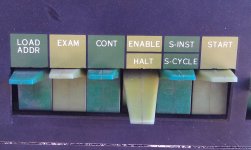Is/has anyone reproduced the PDP8/e orange (two color tones) plastic toggle switches?
Don't have cad or 3-D printer access, so hoping someone already has done this and has these available,
they seem to be a commonly failed part...
thnx Roger in NY
This is a perrenial question that comes up somewhere every year or so. Probably because no readily available high quality solution exists (yet?).
The first challenge is to get something that works like the original -- that lines up properly, etc. There are a number of folks with perfectly fine CAD files that will 3D print something functional, including mine:
http://www.so-much-stuff.com/pdp8/cad/3d.php
If you need small volume and don't want to 3D print a finicky part, you can just order them from Shapeways, etc. That addresses "fit".
"Finish" is a harder problem. The 3D parts have surface texture, even if it's just the matte finish from sintered nylon. (I haven't seen a resin print that is strong enough.) One approach to solve this is to make molds for cast resin parts. This is tractable, and I've been able to make molds that will cast good parts most of the time, even without a vaccum to help remove the trapped bubbles. I reccomend casting about a baker's dozen at a time, both to deal with rejects and to help with color matching.
Color matching is a bear. It is nearly impossible to reliably get a consistent color from batch to batch because of the small volumes of dye involved and such. Not to mention that what constitutes a decent match seems to vary with lighting conditions, etc. etc. The only thing I know that will help with that is to make a whole color set at once, from the same batch of the same material. (I have never pushed it hard enough to get to where I could reliably do this.)
I think it might have been Dave G. who years ago had a handful of batches made by a proper injection molding company, and I have one of those. The colors aren't "right" to my eye, but if you replace a whole panel no one is likely to notice. That's the closest "fit and finish" that I've seen.
Another quibble: I agree that the hinge pins can be replaced to refurbish a handle by using a drill press to drill through the handle body, and installing a rod. I argue that metal (often a straightened paper clip) is the wrong material for the new axle. I want the new axle to buckle if the switch handles are impacted, rather than damage the even harder to replace slide switch underneath. I've had good luck making replacement axles from wood, etc. The result is inexpensive and easily replaced. I can get 1/16" square sticks 3' long at my hobby shop. It only takes seconds to sand the piece you need (just over half an inch) round and install it. (Sand before cutting, so you've got a place to hold onto it. Spin the stick in the abrasive until it is round.)
Vince

